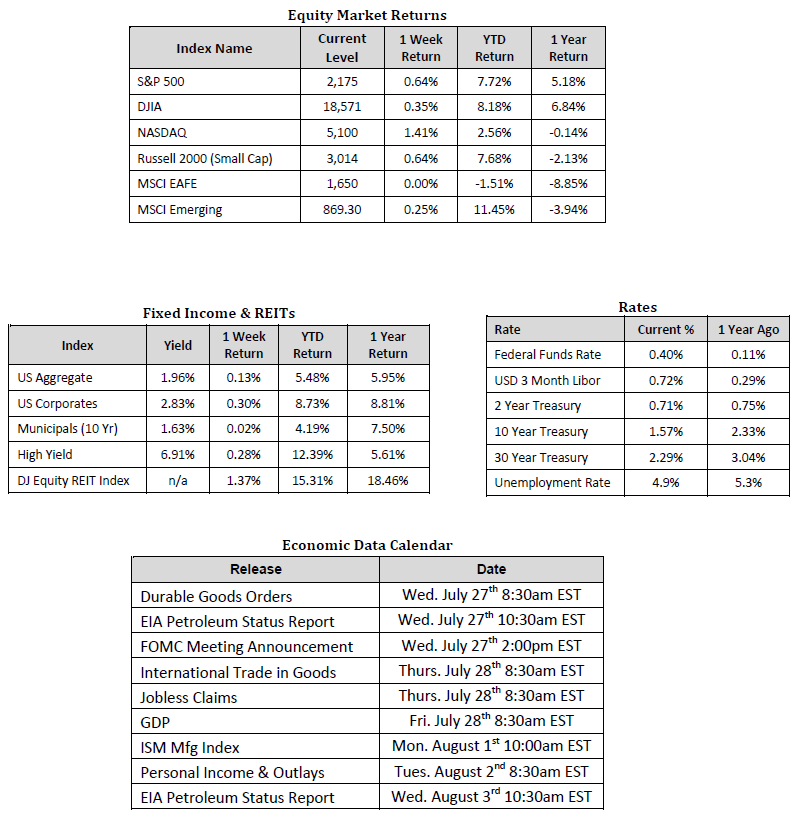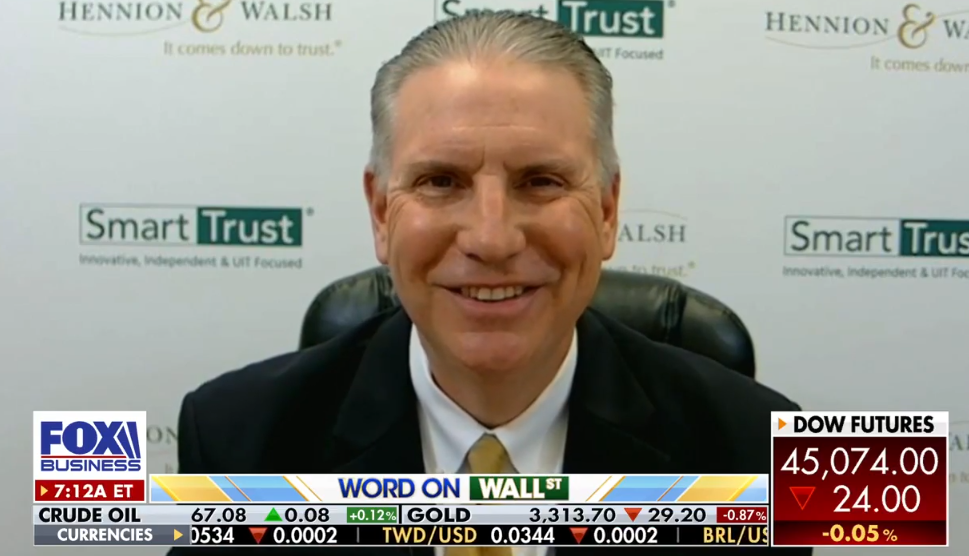
Federal Reserve is Set to Meet As Q2 Earnings are Beating Many Expectations
Market Overview

Sources: Equity Market, Fixed Income and REIT returns from JP Morgan as of 07/22/16. Rates and Economic Calendar Data from Bloomberg as of 07/25/16.
Happening Now
Stocks posted less robust yet still positive results last week amid investor anticipation of upcoming central bank meetings. The S&P 500 Index gained 0.6% and is now up 7.7% for the year as growth stocks have rallied in recent weeks. International developed equity markets* finished the week flat and remain down 1.5% for the year while their emerging equity market counterparts advanced the lead they have on the rest of the world, moving 0.25% higher to arrive at a 11.5% gain since the start of 2016.
As the Federal Open Market Committee (FOMC) is set to begin their two day meeting on Tuesday July 26, second quarter earnings from U.S. companies have been coming in better than expected thus far. As we discussed a few weeks ago, earnings were expected to contract by 5.6% at the start of the Q2 earnings season but now with 25% of companies reporting, this forecast has improved to show a decline of just 3.7%. This improvement has been led by better than expected earnings in the Industrial and Technology sectors. For example, as FactSet points out, Microsoft and Qualcomm, both major players in the Technology sector, have both posted higher than expected earnings while American Airlines and General Electric, two Industrial titans, have also led their respective sector higher.
Not long ago, many had anticipated that the upcoming July FOMC meeting would conclude with the announcement of an additional 0.25% rate hike. However, given the uncertainties created from Brexit among other macroeconomic issues, it is likely to be an uneventful two days. According to the CME Group, there is only a 2.4% probability for a rate hike on Wednesday and only a 42% chance of a rate hike taking place before the end of 2016. Despite concerns of the dovish members of the FOMC, who have time and time again chosen to err on the side of caution, we believe that inflation expectations and the domestic economy can both currently withstand a couple of additional 25bp rate increases in 2016 and would potentially benefit from them. Increases in the Target Federal Funds rate are considered by many to be a vote a confidence in the economy and could lead to additional consumer spending and business investment.
While the Fed weighs tighter monetary policy this week, the Bank of Japan also meets and is expected to announce another round of stimulus. It will be interesting to see the scope of their program and the local market reaction but given the extent of past programs, additional easing has appeared to have a diminishing impact on interest rates, stock prices and the Yen.
Although there are uncertainties in the domestic and global economies, we believe that this secular bull market still has some room to run. We are, however, sensitive to the fact that opportunities are not as easy to come by today as they were five years ago and suggest investors take a careful, disciplined approach to managing current and any future investments.
*International developed equity markets are represented by the MSCI EAFE Index; emerging equity markets are represented by the MSCI Emerging Market Index; both are measured in US dollars, as of 7/22/2016.
Important Information and Disclaimers
Disclosures: Hennion & Walsh is the sponsor of SmartTrust® Unit Investment Trusts (UITs). For more information on SmartTrust® UITs, please visit www.smarttrustuit.com. The overview above is for informational purposes and is not an offer to sell or a solicitation of an offer to buy any SmartTrust® UITs. Investors should consider the Trust’s investment objective, risks, charges and expenses carefully before investing. The prospectus contains this and other information relevant to an investment in the Trust and investors should read the prospectus carefully before they invest.
Investing in foreign securities presents certain risks not associated with domestic investments, such as currency fluctuation, political and economic instability, and different accounting standards. This may result in greater share price volatility. These risks are heightened in emerging markets.
There are special risks associated with an investment in real estate, including credit risk, interest rate fluctuations and the impact of varied economic conditions. Distributions from REIT investments are taxed at the owner’s tax bracket.
The prices of small company and mid cap stocks are generally more volatile than large company stocks. They often involve higher risks because smaller companies may lack the management expertise, financial resources, product diversification and competitive strengths to endure adverse economic conditions.
Investing in commodities is not suitable for all investors. Exposure to the commodities markets may subject an investment to greater share price volatility than an investment in traditional equity or debt securities. Investments in commodities may be affected by changes in overall market movements, commodity index volatility, changes in interest rates or factors affecting a particular industry or commodity.
Products that invest in commodities may employ more complex strategies which may expose investors to additional risks.
Investing in fixed income securities involves certain risks such as market risk if sold prior to maturity and credit risk especially if investing in high yield bonds, which have lower ratings and are subject to greater volatility. All fixed income investments may be worth less than original cost upon redemption or maturity. Bond Prices fluctuate inversely to changes in interest rates. Therefore, a general rise in interest rates can result in the decline of the value of your investment.
Definitions
MSCI- EAFE: The Morgan Stanley Capital International Europe, Australasia and Far East Index, a free float-adjusted market capitalization index that is designed to measure developed-market equity performance, excluding the United States and Canada.
MSCI-Emerging Markets: The Morgan Stanley Capital International Emerging Market Index, is a free float-adjusted market capitalization index that is designed to measure the performance of global emerging markets of about 25 emerging economies.
Russell 3000: The Russell 3000 measures the performance of the 3000 largest US companies based on total market capitalization and represents about 98% of the investible US Equity market.
ML BOFA US Corp Mstr [Merill Lynch US Corporate Master]: The Merrill Lynch Corporate Master Market Index is a statistical composite tracking the performance of the entire US corporate bond market over time.
ML Muni Master [Merill Lynch US Corporate Master]: The Merrill Lynch Municipal Bond Master Index is a broad measure of the municipal fixed income market.
Investors cannot directly purchase any index.
LIBOR, London Interbank Offered Rate, is the rate of interest at which banks offer to lend money to one another in the wholesale money markets in London.
The Dow Jones Industrial Average is an unweighted index of 30 “blue-chip” industrial U.S. stocks.
The S&P Midcap 400 Index is a capitalization-weighted index measuring the performance of the mid-range sector of the U.S. stock market, and represents approximately 7% of the total market value of U.S. equities. Companies in the Index fall between S&P 500 Index and the S&P SmallCap 600 Index in size: between $1-4 billion.
DJ Equity REIT Index represents all publicly traded real estate investment trusts in the Dow Jones U.S. stock universe classified as Equity REITs according to the S&P Dow Jones Indices REIT Industry Classification Hierarchy. These companies are REITSs that primarily own and operate income-producing real estate.



